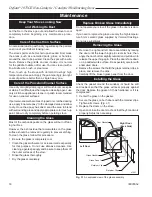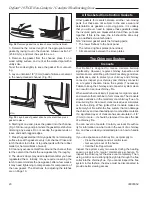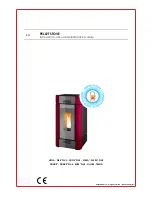
5
Defiant
®
1975CE Non-Catalytic / Catalytic Woodburning Stove
30005554
what kind of chimney to Use
You must connect the Defiant to a code-approved masonry
chimney with a flue liner, to a relined masonry chimney that
meets local codes, or to a prefabricated metal chimney.
(Fig. 3) The chimney and chimney connector must be in
good condition and kept clean.
ST241
chimney types
12/13/99 djt
ST41
A tile-lined
masonry
chimney
A prefabricated double-
wall insulated chimney
Fig. 3
Approved chimney types.
Masonry chimneys
An inspection of the chimney must confirm that it has a lin-
ing. Do not use an unlined chimney. The chimney should
have no cracks, loose mortar, other signs of deterioration,
and blockage. Repair any defects before the chimney is
used with your stove.
Unused openings in an existing masonry chimney must
be sealed with masonry to the thickness of the chimney
wall, and the chimney liner should be repaired. Openings
sealed with pie plates or wallpaper are a hazard and should
be sealed with mortar or refractory cement. In the event
of a chimney fire, flames and smoke may be forced out of
these unused thimbles.
The chimney should be thoroughly cleaned before use.
A newly-built masonry chimney must conform to the
standards of your local building code or, in the absence
of a local code, to a recognized national code. Masonry
chimneys must be lined, either with code-approved ma-
sonry or pre-cast refractory tiles, stainless steel pipe, or
a code-approved, “poured-in-place” liner. The chimney’s
clean-out door must seal tightly.
prefabricated chimneys
These should be an internal diameter of 03 mm (8”) and
be of the twin wall insulated construction that has been
approved for solid fuel use (e.g. Rite Vent ICS of ICID
Lite Chimney Systems). Diameters over 00 mm (8”) are
not recommended due to the large cross-section causing
excessive cooling of the flue gases.
Do NoT coNNecT ThiS UNiT To a chiMNey FlUe
SeRviNg aNoTheR appliaNce.
chimney Size
A Defiant with a 03 mm (8”) flue collar is approved for
venting into a masonry chimney with a nominal flue size
of 03 x 03 mm (8” x 8”) or 03 x 305 mm ( 8” x 1”), and
into a round flue with nominal flue size of 03 mm (8”). A
Defiant with a 15 mm (6”) flue collar is approved for vent-
ing into a masonry chimney with a nominal flue size of 03
x 03 mm (8” x 8”), and into a round flue with nominal flue
of 15 mm (6”).
NoTe: when installed with a 6” flue collar, the Defiant
may not be operated with the front doors open.
Whatever the flue collar size, A Defiant may be vented into
larger chimneys as well. However, chimneys with liners
larger than 03 x 305 mm (8” x 1”) may experience rapid
cooling of smoke and reduction in draft, especially if the
chimneys are located outside the home. These large chim-
neys may need to be insulated or have their flues relined
for proper stove performance.
Accessories to help make the connection between stain-
less steel chimney liners and your Defiant are available
through your local dealer.
chimney connector guidelines
A chimney connector is the double-wall or single-wall pipe
that connects the stove to the chimney. The chimney itself
is the masonry or prefabricated structure that encloses the
flue. Chimney connectors are used only to connect the
stove to the chimney, as in Figure 5.
connecting Flue pipes
Connector pipes should meet the requirements of the build-
ing regulations. This can be achieved by the use connecting
fluepipes included in the following categories:
a) Vitreous enamelled steel pipe complying with BS 6999:
1989 (1996);
b) Pipes made from stainless steel as descirbed in BS EN
1008-1:1995 grades 1.4401, 1.4404, 1.443 or 1.4436 with
flue wall thickness of at least 1 mm;
c) Mild steel fluepipes complying with BS 1449: Part 1:
1991, with a flue wall thickness of at least 3 mm;
d) Cast iron fluepipes complying with BS 41: 1973
(1998).
If you use an existing masonry chimney, it must be in-
spected to ensure it is in a safe condition before the stove is
installed. Your local professional chimney sweep, building
inspector, or fire department official will be able to inspect
the chimney or provide a referral to someone who can.
The flue and chimney design must meet requirement J,
Part J of the building regulations 000 (Combustion Appli-
ances and Fuel Storage Systems).






































